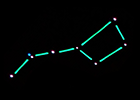|
Disable precedual stars near the solar system
|
|
| Cesrate | Date: Tuesday, 14.10.2014, 04:39 | Message # 1 |
 Astronaut
Group: Users
 China
China
Messages: 68
Status: Offline
| As we have a relatively clear knowledge on the space near our solar system, I suggest disabling procedural stars in this region to represent a "real space".
|
| |
| |
| Freak2121 | Date: Tuesday, 14.10.2014, 05:02 | Message # 2 |
 Space Pilot
Group: Users
 Canada
Canada
Messages: 89
Status: Offline
| I'm fairly certain that's already done.
Intel Core i5 @ 4.534GHz
8GBs of DDR3 RAM @ 1600mhz
EVGA GTX970 SSC
Windows 7 64-bit
|
| |
| |
| Cesrate | Date: Tuesday, 14.10.2014, 06:26 | Message # 3 |
 Astronaut
Group: Users
 China
China
Messages: 68
Status: Offline
| Quote Freak2121 (  ) I'm fairly certain that's already done.
You mean by 0.97.2?
In 0.97.1 there're even two brown dwarfs generated closer than Alf Cen.
|
| |
| |
| FastFourierTransform | Date: Tuesday, 14.10.2014, 13:37 | Message # 4 |
 Pioneer
Group: Local Moderators
 Spain
Spain
Messages: 542
Status: Offline
| Well, that's not imposible. We haven't shown all the brown dwarfs in our zone. Maybe the procedural ones are sufficently dim and cold. Maybe....
|
| |
| |
| pzampella | Date: Tuesday, 14.10.2014, 14:08 | Message # 5 |
 Space Pilot
Group: Users
 Venezuela
Venezuela
Messages: 115
Status: Offline
| I completely agree with FastFourierTransform, we have recently discovered more than one brown dwarf in our neighborhood, so who knows!
|
| |
| |
| cirax | Date: Tuesday, 14.10.2014, 15:25 | Message # 6 |
 Astronaut
Group: Users
 Spain
Spain
Messages: 43
Status: Offline
| Go to the config folder inside SE, open universe.cfg with a text editor like notepad and look up for the line: "StarMaxAppMagn 10.0" and change that number to 20 for example, that value it would disable all procedural stars (and brown dwarfs) in the next 10 parsecs. And of course if bigger is the number, bigger the radius where procedural wont generate. Its related with apparent magnitude so is some unaccurative with distance.
Also the line "StarRelicMinDist 3.0" disables white dwarfs, neutron stars and black holes in the next 3 pc. This value is directly related with distance so you can change also that number if you want.
Finally there is another value "StarGalaxyDensity" that I think changes the density of procedural stars. So take a look inside universe.cfg if interest you too.
And remember to save the changes in universe.cfg! 
Bye!
My work for SE: Click here
Textures for Venus surface in color and the moons of Saturn, Uranus and Neptune.
Catalogs of binary stars, brown dwarfs, black holes and neutron stars.
Proxima b (3 versions).
Edited by cirax - Wednesday, 15.10.2014, 14:20 |
| |
| |
| Fireinthehole- | Date: Tuesday, 14.10.2014, 16:22 | Message # 7 |
 Pioneer
Group: Translators
 Sweden
Sweden
Messages: 365
Status: Offline
| Brown dwarves are so faint and small, they are very hard to detect. There could be many around us, but we don't know they exist. I don't think SE should disable them until we know more.
Love Space Engine!

|
| |
| |
| HarbingerDawn | Date: Tuesday, 14.10.2014, 17:01 | Message # 8 |
 Cosmic Curator
Group: Administrators
 United States
United States
Messages: 8717
Status: Offline
| WISE has done a pretty thorough survey of the solar neighborhood, sufficient to detect any such brown dwarfs if they exist. So if any exist, they would be in the WISE dataset. Seeing as how WISE 0855–0714 - an object much smaller and cooler than any known brown dwarf - has been discovered over 7 ly away, it seems unlikely that any brown dwarfs <4 ly away remain overlooked.
All forum users, please read this!
My SE mods and addons
Phenom II X6 1090T 3.2 GHz, 16 GB DDR3 RAM, GTX 970 3584 MB VRAM
|
| |
| |
| SpaceEngineer | Date: Tuesday, 14.10.2014, 18:34 | Message # 9 |
 Author of Space Engine
Group: Administrators
 Russian Federation
Russian Federation
Messages: 4800
Status: Offline
| Ok, I added two new parameters to the config:
StarNormalMinDist 2.5 // min distance from the Sun to normal procedural stars
StarBrownDwarfMinDist 2.0 // min distance from the Sun to procedural brown dwarves

|
| |
| |
| Fireinthehole- | Date: Tuesday, 14.10.2014, 21:01 | Message # 10 |
 Pioneer
Group: Translators
 Sweden
Sweden
Messages: 365
Status: Offline
| Quote SpaceEngineer (  ) Ok, I added two new parameters to the config:
StarNormalMinDist 2.5 // min distance from the Sun to normal procedural stars
StarBrownDwarfMinDist 2.0 // min distance from the Sun to procedural brown dwarves
Distances in parsecs?
Love Space Engine!

|
| |
| |
| SpaceEngineer | Date: Tuesday, 14.10.2014, 21:56 | Message # 11 |
 Author of Space Engine
Group: Administrators
 Russian Federation
Russian Federation
Messages: 4800
Status: Offline
| of course

|
| |
| |
| Cesrate | Date: Wednesday, 15.10.2014, 01:20 | Message # 12 |
 Astronaut
Group: Users
 China
China
Messages: 68
Status: Offline
| SpaceEngineer, thanks.
Would you like to implement the nearest stars? http://en.wikipedia.org/wiki/Nearest_stars
|
| |
| |
| SpaceEngineer | Date: Wednesday, 15.10.2014, 07:52 | Message # 13 |
 Author of Space Engine
Group: Administrators
 Russian Federation
Russian Federation
Messages: 4800
Status: Offline
| Quote Cesrate (  )
Most of them are already in SE. But if some are not, you may contribute by making a catalog for them. This is the field where your (user) help is highly appreciated, and it is easy. It is better for me to spend a day by finishing the 0.972 release, and hope someone will make a catalog for nearest stars, binary stars, black holes etc.

|
| |
| |
| spacer | Date: Wednesday, 15.10.2014, 10:17 | Message # 14 |
 Star Engineer
Group: Users
 Israel
Israel
Messages: 1258
Status: Offline
| maybe there is brown dwarf that orbit the sun (binary) but we cant see him because he is so dim!
maybe this is the nemesis star
"we began as wanderers, and we are wanderers still"
-carl sagan
-space engine photographer
|
| |
| |
| Watsisname | Date: Wednesday, 15.10.2014, 11:10 | Message # 15 |
 Galaxy Architect
Group: Global Moderators
 United States
United States
Messages: 2613
Status: Offline
| It is a popular idea which is probably not correct. As HarbingerDawn pointed out above, if such an object actually existed, it is hard to explain why we haven't detected it already. WISE is able to see Jupiter-size objects out to 1 light year with surface temperatures down to 100K.

|
| |
| |